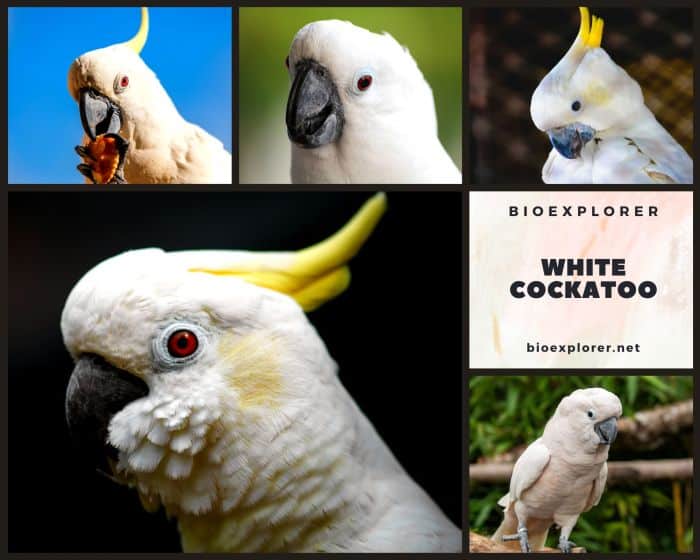
Looking to learn more about the fascinating world of cockatoos? Known for their striking white plumage and showy crests, White Cockatoos are beloved birds brimming with intelligence and charisma.
This in-depth exploration into their lifestyle, habitat, characteristics, and conservation status offers an enriching understanding of these incredible creatures, enhancing appreciation among bird enthusiasts everywhere.
Ready to embark on this avian adventure?
Table of Contents
- Key Takeaways
- The Majestic White Cockatoo: An Overview
- Distribution and Habitat of the White Cockatoo
- Unique Characteristics and Behavior
- White Cockatoo Behavior and Social Dynamics
- White Cockatoo Conservation Status
- FAQs
- Why are Cockatoos Endangered?
- How Do Cockatoos Communicate?
- What Do Cockatoos Eat?
- Are white cockatoos friendly?
- Do cockatoos like to be petted?
- Can cockatoos mimic human speech?
- How many white cockatoos are left in the world?
- Why do white cockatoos scream?
- What is the cacatua alba?
- Where are cacatua alba commonly found?
- What is a white-crested cockatoo?
- What colors are Australian Cockatoos?
- How do Australian Cockatoos reproduce?
Key Takeaways
- White Cockatoos have sharp eyes, dark beaks, and white feathers. They live in Indonesia and Australia.
- These birds eat seeds, nuts, fruit, and vegetables. They can make many sounds, including whistles and songs.
- The IUCN[1] lists the white cockatoo as “endangered“. This is because people often catch them to keep as pets. To help them survive, rules need to be setup against this act.
- White Cockatoos love to socialize. They usually move around in groups of about 20 birds.
![]()
The Majestic White Cockatoo: An Overview
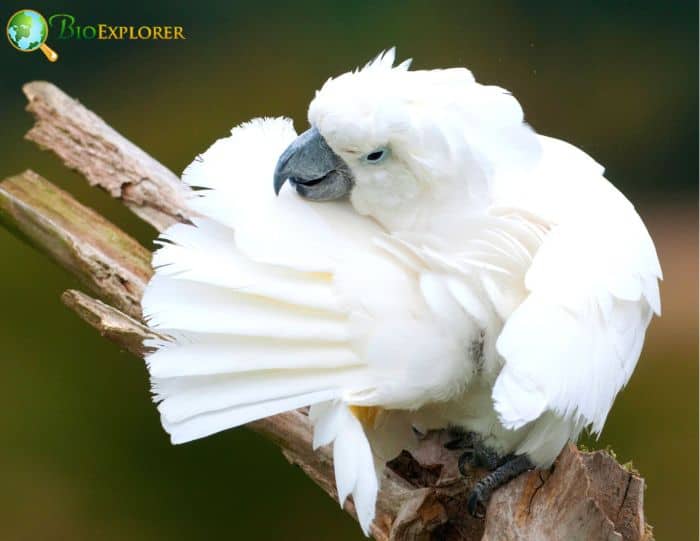
| Animalia | Aves | Psittaciformes | Psittacidae | Chordata | Cacatua alba |
The majestic White Cockatoo stands as an icon in the bird kingdom, lauded for its stark beauty and engaging temperament. Also known as the Umbrella cockatoo or scientifically referred to as “Cacatua Alba“, this fascinating avian species radiates a captivating charm thanks to its spotless white feathered body adorned with a large crest that can be fanned out like an umbrella.
The shimmering white coat, their dark grey/black beak, and beautiful, expressive eyes create a striking contrast, rendering these birds unforgettable once you’ve beholden them.
Native to Indonesia’s tropical rainforest islands and regions beyond where they thrive amidst lush vegetation, White Cockatoos boast many unique attributes. One of them is their impressive size, with adults measuring 45-50 cm from tail to head and around 900g weight on average; indeed, they are sizable parrot family members! Alongside physical prowess, their dietary preferences lean towards plant-based foods comprising seeds, nuts, and fruits galore-an attribute of their herbivorous nature.
Their strong beaks do more than aid feeding; they can exert enough force to break human skin if needed – a testament to their survival skills in the wild.
![]()
Cacatua Alba: The Scientific Perspective
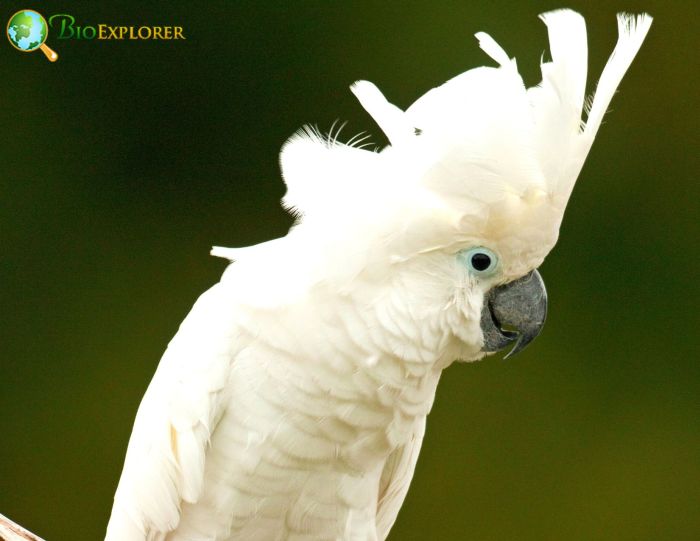
Cacatua Alba is the big name for the white cockatoo. It lives in wet forests in Indonesia. Its snowy feathers and tall crest make it special. This bird can talk like a human if you teach it.
The white cockatoo belongs to the Cacatuidae family, which is full of other cool cockatoos!
![]()
The Umbrella Cockatoo: A Close Relative
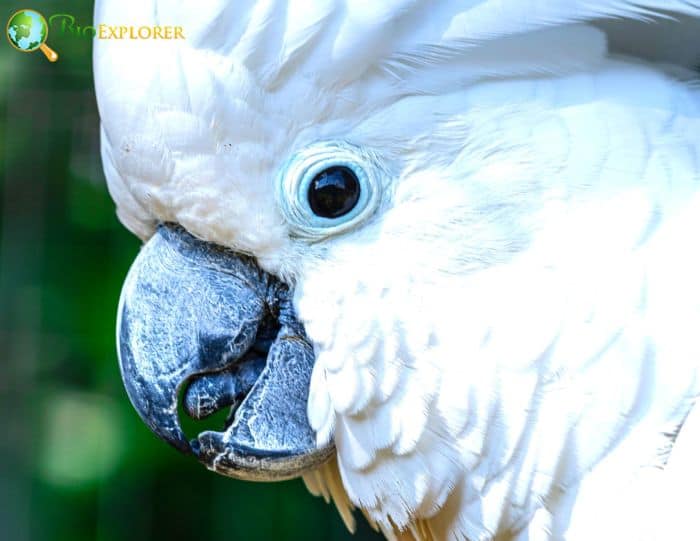
The Umbrella Cockatoo is a bird with all-white feathers. It gets its name from the big crest on top of its head. The crest opens backward like an umbrella, hence its name.
This bird calls Indonesia home. Within deep tropical rainforests and abundant greenery, the umbrella cockatoo thrives best. These birds have strong bonds with their mates, showing unique bonding behavior.
Umbrella cockatoos get excited or upset sometimes, too! When they do, up goes their white crest like an unfolded umbrella. It’s not just fun to look at. Still, it helps them talk in “cockatoo” language by displaying feelings or marking territory!
![]()
Cockatoos of Australia: A Diverse Group
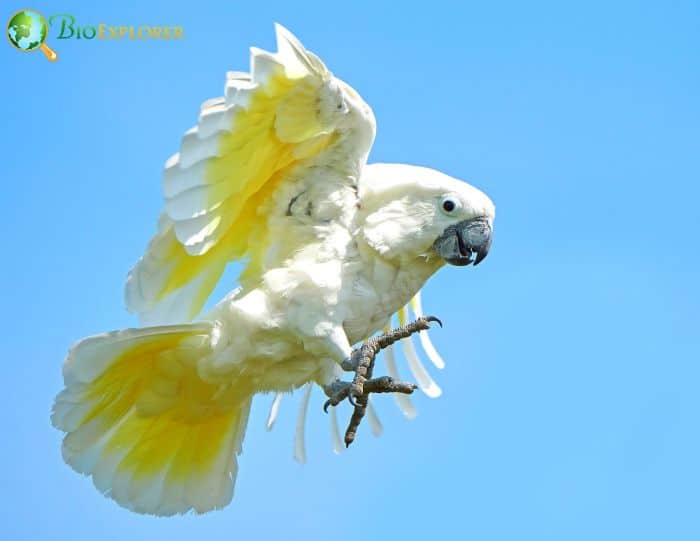
Australia has many kinds of cockatoos. Four types are mostly white. They are part of the Cacatua family. There are black and white ones with red, pink, or yellow hints. Some live in northern and eastern Australia, New Guinea, and Tasmania.
They love to hang out together.
The pink cockatoo lives in the wilds of Australia’s heartland. It flaunts soft, rosy feathers with a special red, yellow, and white crest. People know these birds for their playful ways, and loud calls heard long before they come into sight.
![]()
Distribution and Habitat of the White Cockatoo
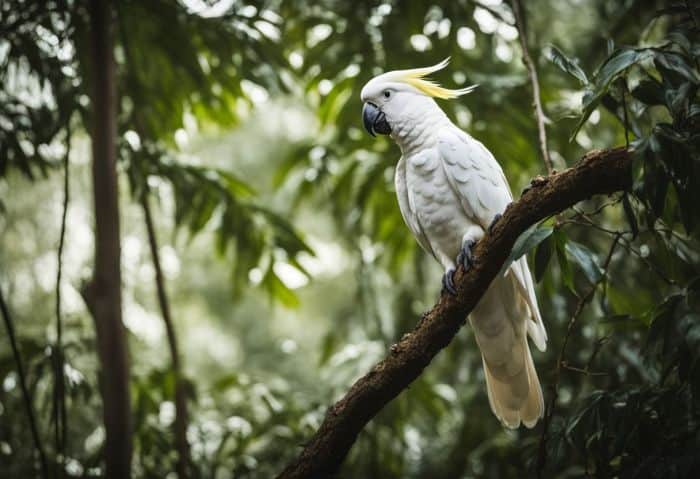
White cockatoos live in the Moluccan islands. These islands are Halmahera, Bacan, Ternate, Tidore, and Kasiruta. They like places with lots of trees. These can be big forests that have never been cut down or smaller ones that people have used for wood.
They also live in farms and crop fields. Sometimes, they go up to high lands 600 meters above sea level! They even like mangroves, a type of tree that grows near water bodies such as oceans or rivers.
For food, cockatoos mostly eat seeds and fruits from different types of plants where they live in their habitats.
![]()
Endemic Regions: Indonesia and Beyond
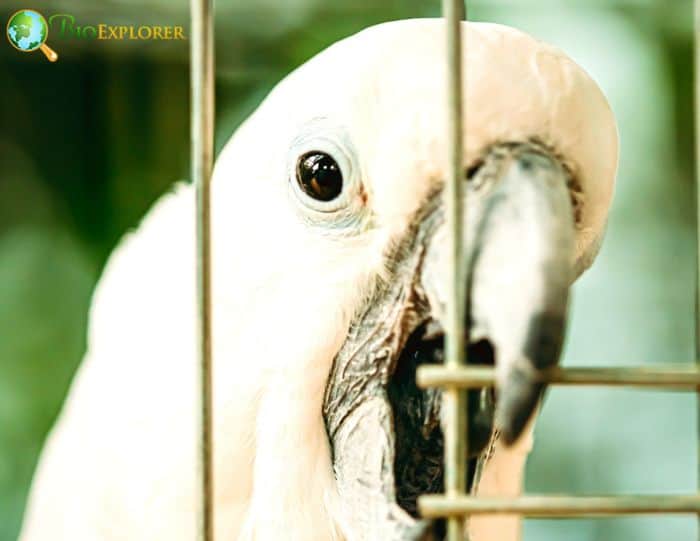
Indonesia is a key home to white cockatoos. They live in the country’s rainforests on islands like Halmahera, Obi, and Bisa. The Maluku area has the Salmon-crested Cockatoo and Purple-naped Lory, too.
White cockatoos also travel past Indonesia to new places. Sadly, many are sold in the wildlife trade today, hurting their numbers badly. Special bird areas, or Ecosystem-based Adaptations (EBA), are planned to keep them safe in Indonesia.
![]()
The Australian Landscape: Home to Diverse Cockatoos
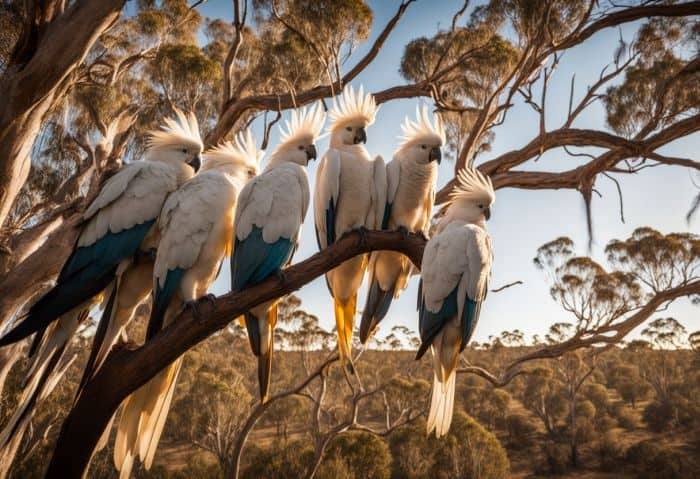
Australia is home to many types of cockatoos. The country’s white Cockatoos are a big part of this group. Their name comes from their light color, white like the clouds in the sky.
These birds live mostly in dry areas.
The Sulphur-crested Cockatoo is one kind you might see a lot. They are loud and flashy birds that love attention! There are also three other kinds of white cockatoos in Australia: Major Mitchell’s, Pink and White-Crested ones.
Each type has its own special look, but they all find homes on this huge land together. From coasts to woods to open fields – these smart birds know how to make the best out of where they live!
![]()
White Cockatoo’s Natural Habitats
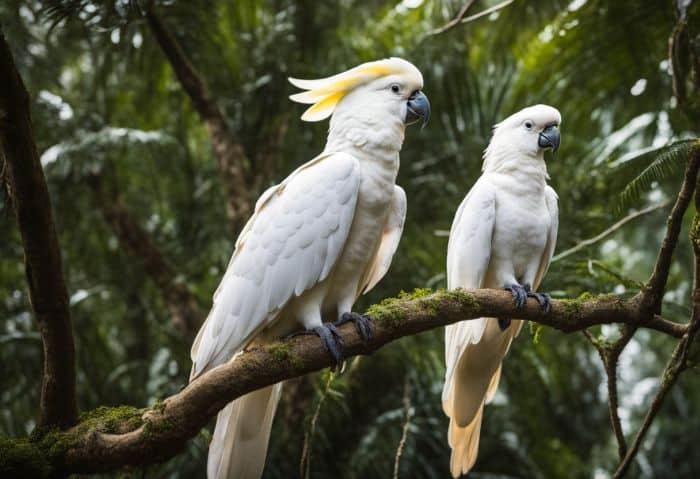
White cockatoos live in many places. They love rainforests and pine forests. Open plains, eucalyptus groves, and woodlands are also their homes. These birds also live on the Indonesian islands of Northern and Central Moluccas.
In the wild, they can also be found in the Maluku Islands in Eastern Indonesia! The White Cockatoo is close to another bird called Tanimbar Corella. Both these birds live on nearby islands in eastern Indonesia.
![]()
Introduced Regions
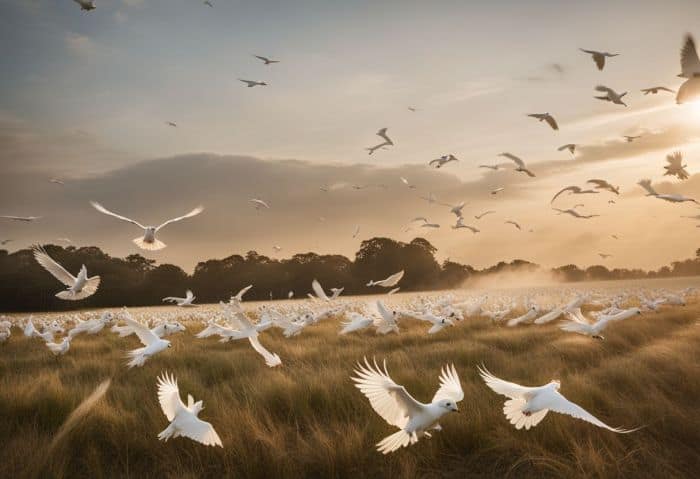
White cockatoos now live in new places. They don’t just live in Indonesia and Australia anymore. People have brought these birds to other parts of the world. These are called introduced areas.
Sometimes, these birds can cause problems in their new homes. They can be invasive, meaning they take over space other animals or plants use. This is most common near farms, as white cockatoos like agricultural land for their food needs.
![]()
Unique Characteristics and Behavior
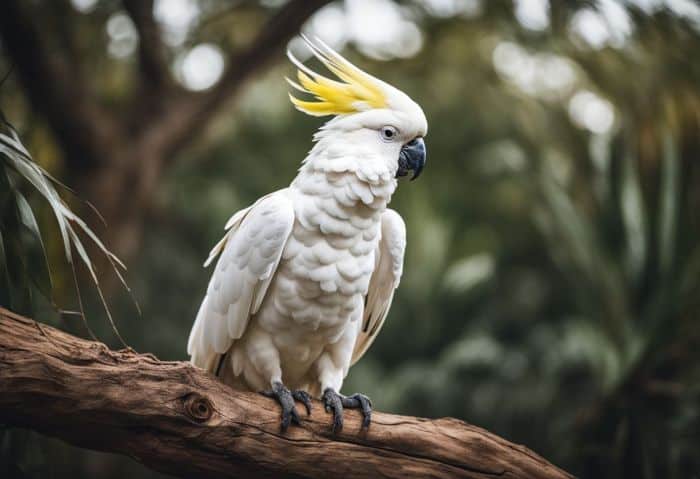
White cockatoos are large, stunning birds. They show off a big white crest on their heads. This crest is like an umbrella when it opens up. Cockatoos have Clear Eyes with a dark grey beak and legs.
The undersides of the wings and tail feathers have short white feathers, too. All four toes on each foot hold onto tree branches tightly! Their loud calls can fill the air from far away.
Cockatoos love to eat nuts, fruits, and seeds – they are herbivores! They can also copy human voices and sounds all around them. Living for many years in captivity or free, these smart birds bring joy everywhere they go.
![]()
Physical Features: From Crest to Tail
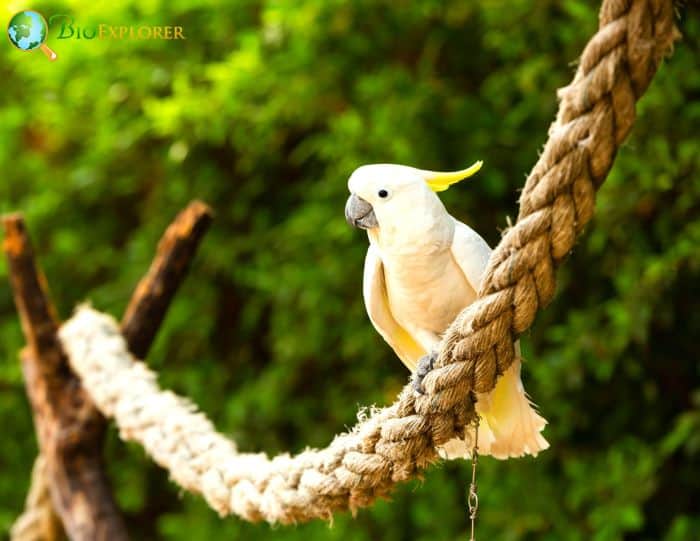
The White Cockatoo, also known as the Umbrellabird, is renowned for its stunning physical attributes. Each feature contributes to its unique aesthetic and functionality, from its backward-bending crest to its blunt-ended tail feathers[2].
| Crest | The White Cockatoo possesses a broad crest that bends backward, giving the bird the appearance of an umbrella. Its crest is predominantly white or pale pink and rises when the bird is threatened, excited, angry, or ready to play. |
| Feathers | The bird’s feathers are blunt-ended, which contributes to its distinctive look. When a male White Cockatoo is courting, he ruffles these feathers, spreads his tail feathers, and extends his wings. |
| Under Wings and Tail | The underside of the wings and tail of the White Cockatoo boast a yellowish coloration, adding another layer of visual interest to this bird. |
| Weight | The weight of a White Cockatoo ranges from 300g to 1,200g (0.66 lbs to 2.65 lbs). |
| Lifespan | The lifespan of a White Cockatoo can vary significantly, ranging from 20 to 70 years in the wild. |
These characteristics enhance the bird’s visual appeal and play vital roles in their survival and reproduction strategies.
![]()
White Cockatoo Sounds and Calls
White cockatoos are quite the talkers! They make many loud sounds. Some may squawk or scream when they see danger. This call is sharp and fast, often sending a clear note of warning.
And they can do more than just squawking. Some white cockatoos also learn to say words like us humans, copying what we say in their own cute voices! But instead of using vocal cords like us, they move parts around in their throat to make these noises.
Plus, there’s much more to their sound-making! They can whistle, sing songs, and even hiss if need be. It’s amazing how one bird can make so many different sounds!
![]()
Dietary Options
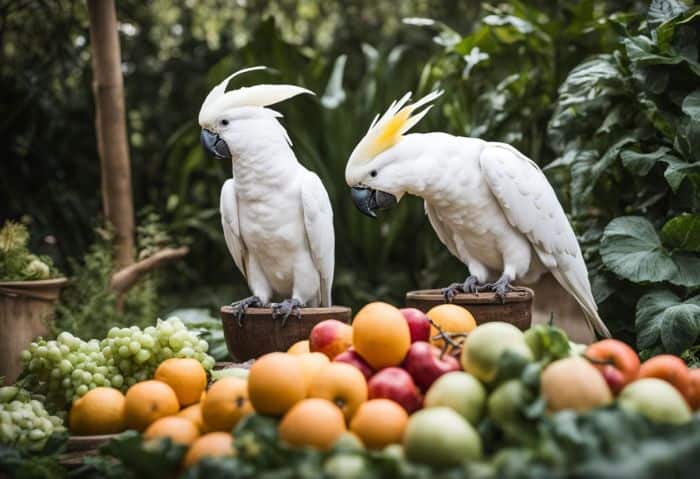
White cockatoos like to eat many types of food. Here’s what they enjoy:
- They love going for nuts, seeds, and fruits. Durians, papayas, langsat, and rambutan are some favorites.
- White cockatoos can get sick without foods full of vitamin A or calcium. So it’s good to give them vegetables and low-sugar foods.
- Cockatoos love to eat off the ground and search high in trees for nuts, too.
- Fresh fruits and veggies are great for their health.
- A mix of pellets or seeds made just for them also helps keep them strong.
- Wild cockatoos munch on fruits, seeds, bugs, and other greens found in nature.
![]()
White Cockatoo Behavior and Social Dynamics
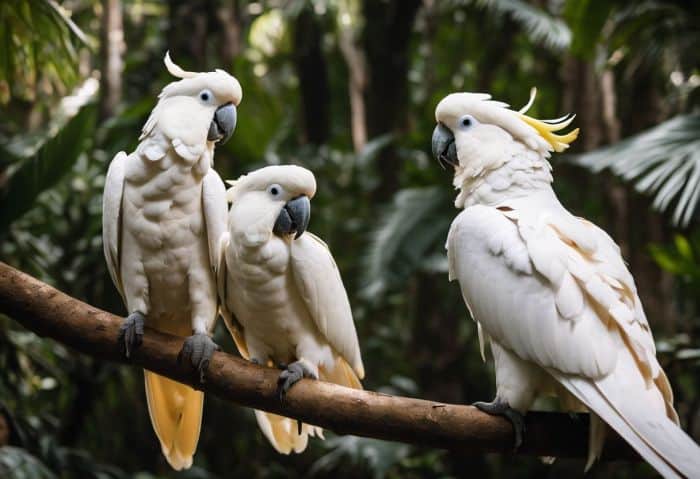
White Cockatoos love to be around others. They often move in groups of about 20 birds. They can show off many moods and are good at solving problems. Their behavior shines out among other birds.
The male cockatoos may show more toughness than the females at times, too. Also, they only have one partner they mate with for life. Together, they care for their young ones in the best way possible.
![]()
Social Behavior
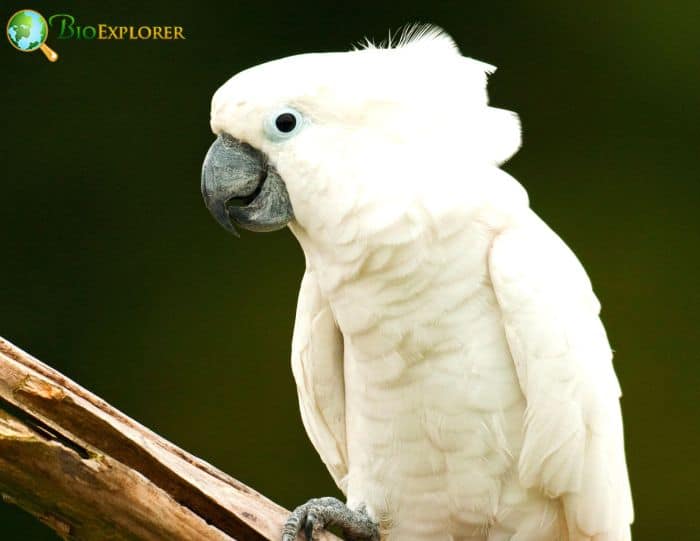
White Cockatoos love to be around others. They often gather in big groups called flocks. This makes them highly social animals. They also talk to each other a lot. This way, they can know who is part of their flock and warn about danger.
These birds show many social actions! For example, they form tight bonds with their mates and friends in the flock. They look for food as a team, too! You can find dozens or even up to 100 of them together during this time.
At night, they come together at certain spots to sleep.
![]()
Nesting & Reproduction
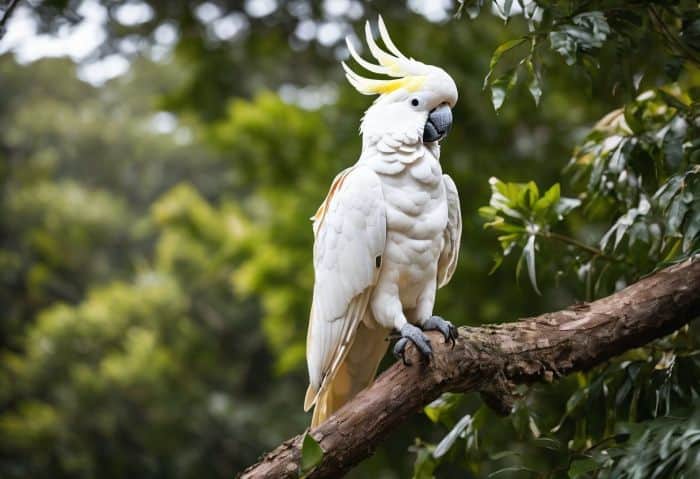
White Cockatoos choose big trees for their nests. Both males and females care for the eggs in the nest. The time to have babies is from October until May or June. During this time, the female lays two or three eggs once a year.
The shared work of both parents helps keep the eggs safe and warm.
![]()
White Cockatoo Conservation Status
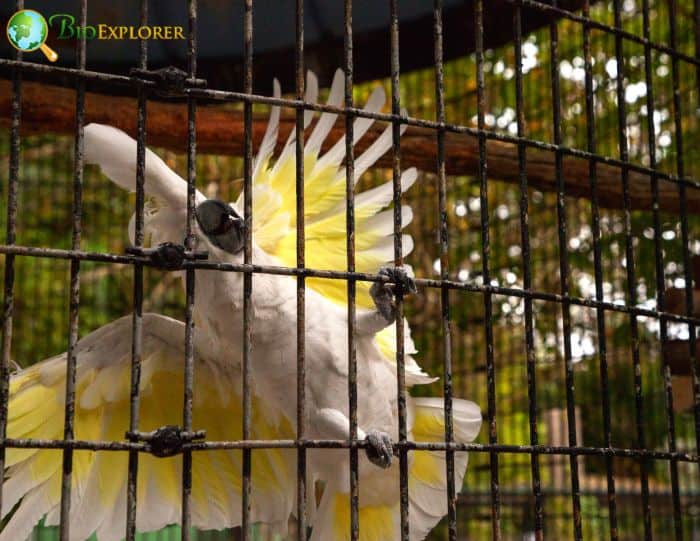
The white cockatoo faces some hard times. The IUCN puts it in a group called “Endangered“. This means the bird may not have many safe places to live and grow. Many things cause this issue, but one big problem is people catching them for pets.
They think the birds are nice to look at or play with and forget they must be free. About 17% of all wild white cockatoos get caught like this! It’s a big hit on their number in nature, where they should be living.
To keep these birds around, we must act now. We need rules to stop people from taking them as pets. If we do nothing, there will be fewer and fewer each year until one day, there might not be any left! Every step taken can make a change, no matter how small it seems.
So, let’s help save the beautiful white cockatoo before it becomes too late!
![]()
FAQs
Many want to know if White Cockatoos are friendly. Yes, they can be! These birds love being around others. They also enjoy it when you pet them. Yet, their loud calls might scare some people.
A lot of people ask why Cockatoos scream. This is because that’s how they talk to each other. Fun fact: these cute pets can copy human speech, too!
But there’s a downside, too. Sadly, the number of White Cockatoos left in the world is dropping fast due to losing their home and food.
Cacatua alba, or white cockatoo, mostly lives in parts of Indonesia. Still, many have found homes in different places around Australia and other parts of the world.
Therefore, all aware individuals must strive towards creating safe habitats for these wonderful creatures, which can help ensure their survival & growth over time.
Why are Cockatoos Endangered?
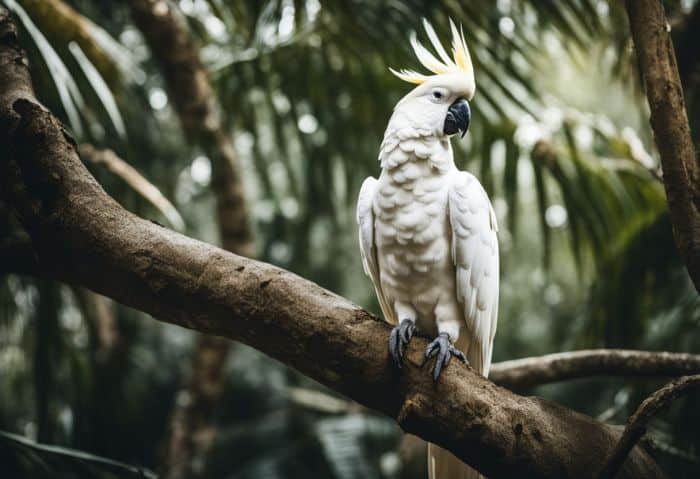
Cockatoos face danger. They are at risk all around the world. People love them as pets because they can learn to talk. So, a lot of people trap them to sell. This causes their numbers to go down very fast.
Their homes also get destroyed by people building houses and cities where forests once stood. Cockatoos need trees for food and nests. Without those trees, cockatoos find it hard to live and breed happily like before.
Many die or move away in search of new homes.
How Do Cockatoos Communicate?
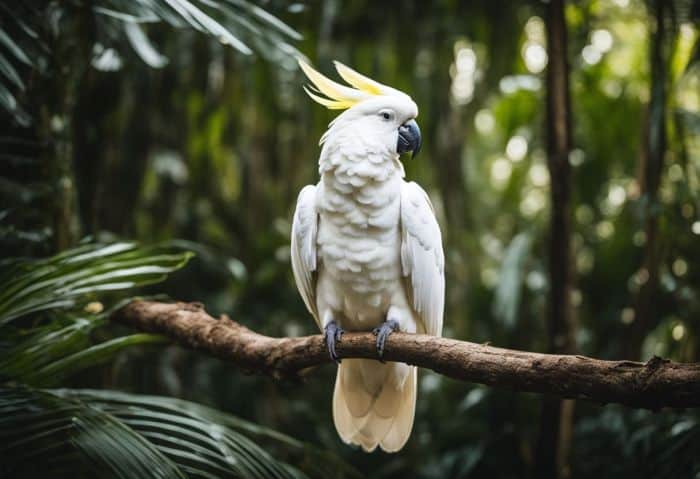
Cockatoos use many ways to talk with each other. They have a lot of calls they can make. Some calls are loud, and some are soft. Non-vocal signs like moving their wings or heads also help them talk.
White Cockatoos even work as a team to look for food or keep safe from harm. Each bird sends clear signals so the flock knows what’s happening.
What Do Cockatoos Eat?
Cockatoos love to eat a lot of things. They are herbivores, eating nuts and seeds most of the time. Peanuts and sunflower seeds are their top picks. Cockatoos also munch on fruits like durian, papaya, langsat, and rambutan.
Besides these, they have veggies in their meal, too. There is more! You may also see them chowing down on insects or insect larvae. So, we can say that cockatoos eat plants and small bugs, making them omnivorous birds.
Are white cockatoos friendly?
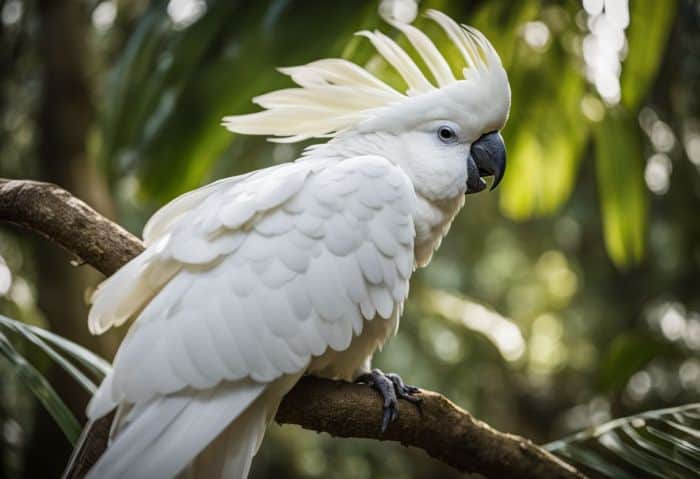
Yes, white cockatoos are friendly. They love to bond with their owners. These birds love you so much it feels like they glue on you! That’s why some people call them “velcro birds. ” As pets, they show a lot of care and affection towards humans.
Their big personalities make them fun pets, too. So, if you get one as a pet, be ready for lots of friendship and fun times together!
Do cockatoos like to be petted?
Cockatoos do enjoy being petted. They are known to be very sweet birds that can form strong bonds with humans. These unique traits make them great friends for people everywhere.
Some cockatoos even seek out touch and cuddles from their owners! You’ll often find these affable birds wanting a scratch or stroke. However, remember each bird is individual and may have different comfort levels with physical affection.
Can cockatoos mimic human speech?
Yes, cockatoos can copy human speech. Some do it very well because they can make low-note sounds. Not every cockatoo is a great talker, but they all try to speak or make noise to say something.
The White Cockatoo is known for making many sounds like words people say. People who have these birds as pets love this about them.
How many white cockatoos are left in the world?
The white cockatoo, also known as cacatua alba, is facing risk. Loss of homes and illegal pet trade harm the bird’s numbers. The International Union for Conservation of Nature says they are ‘endangered’.
This means trouble lies ahead if no changes take place. It is hard to say the exact number that remains in the wild. Yet, experts predict[5] there could be fewer than 43, 000 left on Earth.
Why do white cockatoos scream?
White cockatoos scream for many reasons. They might want you to see them or hear their sounds. If they are not happy, they will make loud noises, too. Sometimes, if a white cockatoo is bored and has nothing to do, it can start screaming loudly just because of that boredom! Other times, it could be that the bird’s home is stressful like if there’s not good food or someone harms it, then a lot of screaming happens.
Some kinds of white cockatoos, such as Moluccan ones, also tend to be very noisy most of the time and can appear to suddenly burst into screams even when nothing seems wrong with them! It’s important to keep your pet bird busy so it doesn’t get bored – this will help cut down on all their yelling and keep things quieter for everyone!
What is the cacatua alba?
The cacatua alba is another name for the white cockatoo. This bird lives only in certain parts of Indonesia, on islands like Halmahera, Bacan, and Ternate. It has a pure white body, but its wings and tail have some yellow color when stretched out.
People often call it the Salmon-crested Cockatoo because of this mix of colors.
You can easily spot this medium-sized bird in places with many trees, like Tropical Rainforests. Yet you may see them not just in nature but also as pets at home due to their charm and unique look.
Where are cacatua alba commonly found?
The White cockatoo, or Cacatua alba, lives in the North Moluccas region of Indonesia. It feels most at home in tropical rainforests on various islands there. You can also find it near clearings and rivers or forest edges.
However, it is not native to Australia or any South Pacific Islands.
What is a white-crested cockatoo?
A white-crested cockatoo is an Australian bird known for its large size, also called the Major Mitchell’s or Moluccan cockatoo.
What colors are Australian Cockatoos?
Australian Cockatoos are mostly large and white with dark brown or black eyes. They have long crests on their heads and tails with feather-covered eye-rings.
How do Australian Cockatoos reproduce?
Cockatoos are monogamous, where the male mounts the female to help raise chicks. Caring usually lasts 30 days, and then chicks learn to fly independently. Sometimes, the mother might raise only one chick & try again later for a second one.
The White Cockatoo is quite a sight with its large crest and bright colors. These lively birds make fun pets but need lots of care. It’s up to us to keep these precious birds safe in both our homes and the wild.
Let’s do our part!
![]()











